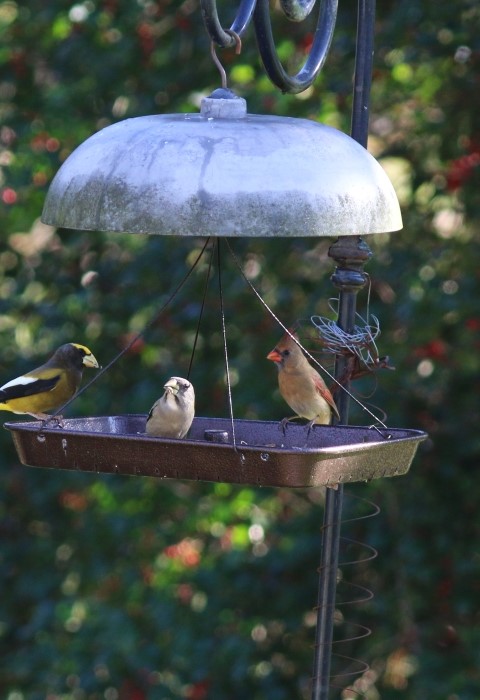
Having a bird feeder in your yard can attract a wide variety of birds. Many different types of birds, including birds such as orioles and hummingbirds, use bird feeders for their daily nectar. You can find different types of bird feeders, such as platform feeders, tube feeders, and suet feeders.
Platform feeders
Unlike traditional bird feeders, platform feeders attract birds by offering them a choice of foods. You can fill the feeder with a wide variety of food, from seeds to nuts and even fresh fruits. These feeders are perfect for both perching and ground feeding healthy food for birds. Whether you want to attract Blue Grosbeaks, Black-headed Grosbeaks or European Starlings, you can find a platform feeder to suit your needs.
A platform bird feeder is a large tray that is usually suspended above the ground. The tray has a small opening at the top for food and water. A platform feeder can be set on a deck railing, a garden wall or even hung on a tree branch. It is a simple, yet effective way to attract a variety of birds to your yard.
It is not uncommon for platform bird feeders to attract pigeons and other wild birds. These birds are often fed mealworms. Mealworms are a good choice for attracting Eastern and Western Bluebirds.
The open design of a platform feeder makes it easy to fill. Some models have a roof for rain protection. It is also easy to clean. You can clean the platform with a brush, a water-vinegar solution or even bleach.
You can also get platform bird feeders with a squirrel baffle. This will prevent squirrels from grabbing your food. This will keep your feeder clean and sanitary.
Another option is to use a dedicated squirrel feeder. This is a better option than a platform feeder. These feeders are more durable, and they usually hold more food.
This easy to set up and maintain. If you are a backyard bird enthusiast, you can find a platform feeder for sale from Backyard Chirper. They offer platform feeders at very affordable prices.
Tube feeders
Choosing the right type of tube bird feeder can make all the difference when it comes to your backyard birds. For instance, if you have a house sparrow, a squirrel or a larger bird, choosing the right type of feeder is essential.
Tube feeders are available in a wide variety of designs and sizes. They are also very easy to clean and maintain. In addition to being squirrel proof, they are designed to attract many different species of backyard birds.
Many tube feeders are hung from tree limbs or hooked to a pole. They are usually designed to hold a variety of seeds. They also help protect seeds from rain, snow and other weather conditions.
Many tube feeders are designed for small birds and come in a variety of sizes. Some are made of wood, while others are made of wire mesh. The best tube feeders have metal screens to keep out squirrels.
Some feeders come with a small tray at the bottom of the feeder to catch bird waste. This tray also helps prevent spillage.
Some feeders are made of clear polycarbonate plastic. Others are made of PVC pipes. Some tube feeders have small openings or perches above the feeding ports.
These tubes may attract small birds such as chickadees or squirrels. They may also be squirrel resistant. Some tube feeders have internal baffles to help distribute seed evenly.
Some tube feeders are made to hold a single type of seed. Others are designed to dispense seed mixes. There are also feeders that are designed to hold large amounts of seed.
Tube bird feeders are the most common type of feeders. They are easy to maintain and attract a wide variety of birds.
Suet feeders
During the spring and summer months, birds will flock to suet bird feeders. These feeders are great for attracting a variety of birds, including chickadees, robins, and quail. In addition, they also attract woodpeckers.
There are many types of suet bird feeders available. Some are simple logs drilled with holes, while others are more sophisticated and come with a roof. You can choose the one that best suits your needs.
If you live in a climate where you receive frequent rain and snow, you’ll want to choose a suet bird feeder with a roof. This will keep your suet dry and cool.
If you don’t have a roof, you can hang your suet feeder from a branch. In addition, you can also place it in your backyard. If you want to attract birds, you can also purchase a suet feeder that is pole mounted. It’s also easy to clean.
In addition, some suet bird feeders have a double-locking system. This prevents the suet from falling out of the feeder. The lock is also durable, so you won’t have to worry about it falling off when your birds start feasting.
Many suet bird feeders also feature baffles, which help protect them from predators. This is especially important during nesting season, when birds will be excavating a lot of cavities to protect their young. You can also plant a shrub or tree nearby, which will provide a hiding place for your birds.
While most birders give suet during the colder months, you can also put it out during the spring and summer. This will provide a good source of fat for birds, and it’s also a nutritious treat for them.
Hummingbirds and orioles like nectar from bird feeders
Besides the hummingbird, another bird that drinks nectar from bird feeders is the oriole. Like hummingbirds, orioles are migratory birds. They can be found throughout the Western Hemisphere.
The main difference between the two birds is that the hummingbird tends to eat smaller insects while the oriole eats larger ones. Orioles are known to be aggressive and may harass hummingbirds, particularly if they are trying to drink from a feeder.
The best type of food for orioles is grape jelly. The high calorie content of this food will attract the birds and they will not leave it alone. The jelly is a good substitute for a sugar solution. Nevertheless, it does not provide the essential nutrition needed for the birds.
Another alternative is orange marmalade. Orioles love oranges and they sip the juice from them. Another favorite of the bird is the wild black cherry tree blossoms.
The best time to put a nectar feeder up is in the spring. The feeder should be placed at least three months before the spring. You can also place the feeder during the fall.
The best time to change the nectar is three to five days after you feed the birds. This will keep the birds healthy and ensure that they are drinking fresh nectar.
You can also provide water to the hummingbirds and orioles. This is a cheaper option. It is also important to provide water to the migrating birds. This is because providing water will make the birds more resistant to disease.
When you are making the nectar, you should choose a ratio of one part white sugar to four parts water. This is a good ratio because it approximates the sugar content of flowers.
Keep pests away from your bird feeders
Keeping pests away from your bird feeders can be a challenge. Luckily, there are a few tips that will help you keep your feathered friends happy and your yard clean.
Bird seed is a tempting snack for a plethora of critters. The best way to keep pests away from it is to keep your feeder clean. The seed should be stored in a galvanized metal can with a tight-fitting lid. This will keep out insects and keep water from pouring in.
Another tip to keep pests away from it is to put out a few small containers of pest-proofing pellets. These pellets are little nuggets of repellant that can be scattered around the feeder. This will keep critters from snagging on your birdseed and moving into your home.
Another tip to keep pests away is to place it in an out of the way spot. These are notorious for spilling seed. If your feeder is broken or if the weather is bad, seed will spill out and attract critters.
If you have a hanging feeder, it may be a good idea to add a baffle to the top of the feeder. A baffle is a conical piece of plastic that fits over the top of the feeder. It is designed to keep pests from climbing up the feeder to get to the bird seed.
Another tip to keep pests away includes the raking of the ground around it. This is important to ensure that no unwanted guests get into your humming.
Aside from pests, you’ll also want to keep your it clean. You don’t want to be cleaning up bird seed every day. You’ll want to clean it at least once a month to prevent pests from re-entering your yard.
| You may also read : The Complete Guide To Carpet Cleaning Services |


